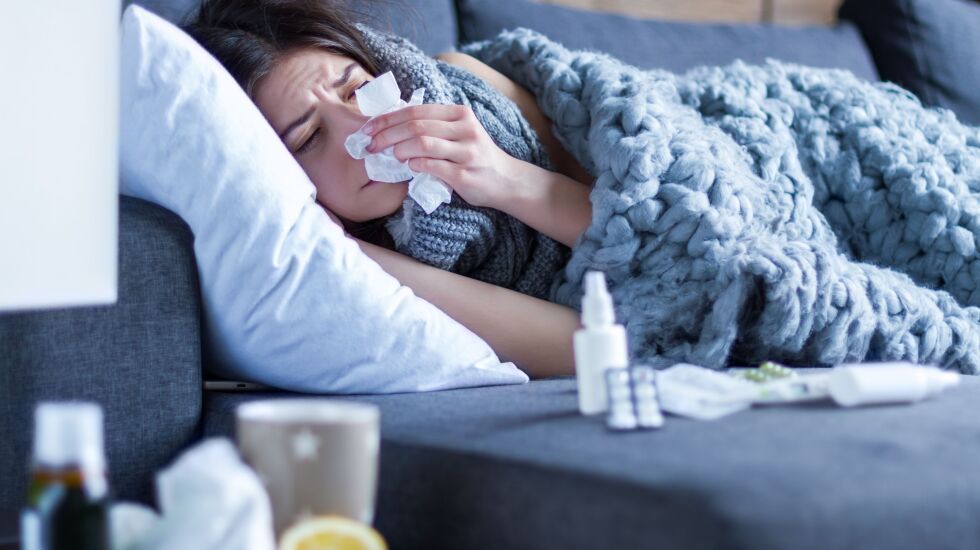
In case you couldn’t tell by all of the sniffles and coughs around you, cold season is in full swing.
We’re seeing an influx of cases of RSV, flu and COVID-19 — and a shortage of over-the-counter pain medication for children.
If you’re sick, health experts say it’s important to stay home and rest to allow the body to recovery and prevent transmitting the virus to others.
But some cold symptoms can last for weeks. How do you know when it’s the right time to return to daily activities? Here’s what experts say.
Can you have a fever with a cold?
Fevers aren’t common with colds, but it can happen, said Dr. Joseph Khabbaza, a pulmonary and critical care physician at the Cleveland Clinic.
Typical cold symptoms
- Runny or congested nose.
- Cough.
- Sore throat.
- Mild headache.
- Sneezing.
How long does a cold last?
Cold symptoms typically last seven to 10 days and are most contagious in the first four to five days, said Dr. Maria Eugenia Petrini, medical director of clinically integrated network at Nemours Children’s Health.
Can cold weather cause a cold?
“Bundle up, or you’ll catch a cold!” That’s an age-old expression parents say to their children refusing to wear their winter jackets. But a recent study found they might be right.
Researchers from Northeastern University studied nasal samples and found immune mechanisms in the nose worked differently at different temperatures. In normal body-heat conditions, the nose successfully deployed extracellular vesicles that bond and block viruses from entering the body. But just a five-degree drop in temperature led to a 50% decrease in immune activity.
“Our study is really focused on prevention, that initial exposure and how to enhance your defenses,” said lead author Mansoor Amiji, a Northeastern professor of pharmaceutical sciences.
How to treat a cold
Unlike bacterial infections, antibiotics don’t have any impact on respiratory viruses. This means the best thing to do is drink lots of fluids and rest while the virus runs its course, Petrini said.
Many people rely on pain relievers to alleviate cold symptoms. But a shortage of over-the-counter medication for kids has put some parents in a panic. Health experts say there are ways to treat a cold at home without medications:
- Drink lots of fluids. Yes, that includes chicken noodle soup. Water and other clear liquids are best, but experts also say warm apple juice or lemonade are fine for young children.
- Get plenty of rest.
- Stay comfortable. Wear loose-fitting clothing or take lukewarm showers or baths if you have a fever. Avoid cold baths. Those could make you shiver and raise your body temperature.
- Congested? Turn on a humidifier.
What can make a cold worse?
Anything that weakens the body’s immune system could keep you from getting better more quickly. This includes physical exertion, intense stress and smoke and alcohol.
“You can prolong recovery if you don’t give yourself the extra time to recover,” Petrini said.
When can you return to daily activities?
Experts urge people to stay at home while sick to prevent transmitting viruses.
“People think they can continue their routine life, but if you have a cold, you’re going through a viral process that’s contagious,” Petrini said. “Staying at home when you feel sick is the right thing to do for yourself and for others, too.”
After a week or two, it’s OK to start returning to daily activities even if there are still lingering cold symptoms. But it’s important to listen to your body’s limitations.
Gym: “Go back gradually rather than going into a full swing,” Petrini said. “Instead of taking a full class, take a half class, test the waters, see how the body reacts to that the exercise and the demand.”
Office: “We always say to kids to be able to go back to school . . . they need to be fever-free for 24 hours, and symptoms need to be getting better,” Petrini said. The same goes for adults,if they’re not feeling too fatigued.
Read more at usatoday.com







